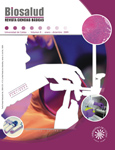Authors
Abstract
This research evaluated the effect on blood sugar levels in the aqueous extract of Senna reticulata (common name: pasture killer) leaves, administered to rats with Aloxan induced diabetes. Blood glucose was measured on an empty stomach on day 0, 7 and 15 in the control group and the treatment group. The analysis of results showed that administering the extract reduces blood sugar levels when compared with the values of day 0, and with the control group on days 7 and 15. Even though these effects were not statistically significant, they show clear signs that this plant has hypoglycemic actions that must be studied in future studies.
References
Farnsworth NK, Akerele O, Bengel AS, Suejanto DD, Guo Z. Las plantas medicinales en la terapéutica. Bol Of Sanit Panam 1989;107(4):4314-29.
Bueno JG, Isaza G, Gutiérrez F, Carmona WD, Pérez JE. Estudio etnofarmacológico de plantas usadas empíricamente por posibles efectos inmunoestimulantes. Rev Med de Risaralda 2001;7(1):7-11.
Isaza G, Bueno J, Jaramillo R, Gutiérrez F, Guzmán AM. Estudio etnofarmacológico de plantas usadas empíricamente en 4 ciudades del centro-occidente colombiano. Medomai 2001;2(1):8-9.
Aschner P, King H, Triana de Torrado M, Marina Rodríguez B. Glucosa Intolerante in Colombia. A population based survey in an urban community. Diabetes care 1992;16(1):90.
King H., Aubert R F., Herman W H. Global Burden of Diabetes, 1995-2025. Diabetes care 1998;21:1414-1431.
Sweetman Sean C. Martindale, The complete Drug Reference. Pharmaceutical Press. 34 ed. 2005. Antidiabetics, pp. 324-348.
American Diabetes Association. Standards of medical care in diabetes. Diabetes Care 2006;29(Suppl):S4-S42.
Arango MC, Duque N, Isaza G. Análisis fitoquímico preliminar y del efecto hipoglicemiante de la Zebrina pendula. Rev. Universidad de Caldas 1993;13:55-76.
Gutiérrez F, Isaza G, Bueno JG. Efectos del Poligonum segetum sobre la glicemia de ratones normales y con diabetes experimental. Biosalud 2002;1:5-9.
Isaza G, Cristancho LE, Cruz A, Castillo HJ. Efectos de la Senna reticulata en la glicemia de ratones normoglicémicos e hiperglicémicos. Biosalud 2006;5:61-67.
Giraldo U, Arango MC, Duque N, Isaza G. Estudio toxicológico de las hojas de Zebrina pendula. Rev. Universidad de Caldas 1995;15:51-57.
Arango MC, Isaza G, Bohórquez A, Chica LF, López H. Determinación de la toxicidad subaguda de la Zebrina pendula en ratones. Biosalud 2005; 4:56-66.
Isaza G, Arango MC, Buriticá OP, Marulanda H. Determinación de la toxicidad subcrónica de la Zebrina pendula en ratones. Biosalud 2005;4:67-77.
American Society of Health-System Pharmacistis. American Hospital Formulary Service (AHFS). Drug Information 2008;3176-3269.
Isaza C, Isaza G, Fuentes J, Marulanda T. Fundamentos de farmacología en terapéutica. 5ª edición. Pereira: Postergraph; 2008. pp. 297-305.
Ahren B, Landin-Olsson M, Jansson P-A, et al. Inhibition of dipeptidyl peptidase-4 reduces glycemia, sustains insulin levels and reduces glucagon levels in type 2 diabetes. J Clin Endocrinol Metab 2004;89:2078-2084.
Zieve FJ, Kalin MF, Scwartz SL, Jones Mr, Bailey Wl. A ramdomized, double blind, placebo-controlled pilot study evaluting de effect of colesevelam hydrochloride on glycemic control in subjects with type 2 diabetes. Clinical Therapeutics 2007;29:74-8.
Mateos N., Castillo R., Tratamiento farmacológico para la diabetes mellitus. Revista Hospital General Dr. M. Gea González 2002; 5(1 y 2):33-41.
Chandra Prasad PR, Reddy SC, Raza SH, Dutt CBS. Folklore medicinal plants of North Andaman Islands, India. Fitoterapia 2008;79(6):458-464.
Qureshi R, Bhatti RG. Ethnobotany of plants used by the Thari people of Nara Desert, Pakistan. Fitoterapia 2008;79(6):468-473.
Cunna WR, Arantes GM, Ferreira DS, et al. Hypoglicemic effect of Leandra lacunosa in normal and alloxan-induced diabetic rats. Fitoterapia 2008; 79(5):356-360.
Corral Salvado A, De la Paz Naranjo J, Concepción Eseevea E, et al. Tamizaje, tecnología, control de calidad y farmacología del extracto fluido de Bouganvillea spectabilis Willd. Rev Cubana Plant Med 1997;2(2):19-25. ISSN 1028-4796.
Deas Domínguez M, Seuc Jo A, Gonzáles Suárez R. Estudio del efecto hipoglicemiante del Ocimun sanctun L. (albahaca morada) con el uso de un ensayo biológico en ratones. Rev Cubana Plant Med 1997;2(1):15-18. ISSN 1028-4796.
De la Paz J, Corral Salvado A, Rivero Jiménez G, Fernández Menéndez M, Pérez Santoya P. Efecto hipoglucemiante del extracto fluido de Tecoma stans linn en roedores. Rev Cubana Med Milit 2003;32(1):19-23.
Nagarajan NS, et al. Antidiabetic and antihyperlipemic effects of Clemeo feline. Fitoterapia, the journal for the study of medicinal plants [Milano Italia] 2005;76(3-4):310-315.
Murillo E, Moreno M L, Gutiérrez N. Estudio del efecto hipoglicemiante de Cordia alliodora (Nogal cafetero) en ratones tratados con aloxano. Vitae [Medellín] 2004;11(01):42-48.
Melchor G, et al. Actividad hipoglicemiante oral de Allophylus cominia SW (palo de caja) en ratas normoglucémicas. Revista de salud animal [La Habana] 1999;21(01):35-38.
NAPRALERT. Profile for Senna reticulata. (nap, 07/08/2005).
NAPRALERT. Profile for Chamaesena reticulata. (nap, 07/08/2005).
Programa Iberoamericano de Ciencia y Tecnología para el Desarrollo. CYTED. Manual de Técnicas de Investigación. Actividad hipoglicemiante. CYTED;Bogotá, Colombia; 1995. pp. 173-191.
Ministerio de Salud. Dirección de Desarrollo Científico y Tecnológico. Normas científicas, técnicas y administrativas para la investigación en salud. Resolución No. 008430 de 1993.
Mrad de Osorio A, Rosenkranz A. Guía para el uso de animales de laboratorio. Departamento de Farmacia. Facultad de Ciencias. Universidad Nacional de Colombia. Bogotá; 1990.
Harrison et al. Principles of Internal Medicine. 15a. ed. USA: McGraw-Hill; 2001. pp. 2109-2137.
Gonen B, Rubenstein AH, Rochman H. Hemogloblin A: en indictor of the metabolic control of diabetic patiens. Lancet 1977;2:134-135.
Inzucchi S. Oral anti-hyperglycemic therapy for type 2 diabetes: scientific review. JAMA 2002;287:360-72.
Ryden L, Standl E, Bartnik M, Van den Berge G, et al. Guidelines on diabetes, prediabetes and cardiovascular disease. Eur Heart J 2007;9(Suppl C):C3-C74.

 PDF (Español)
PDF (Español)
 FLIP
FLIP














